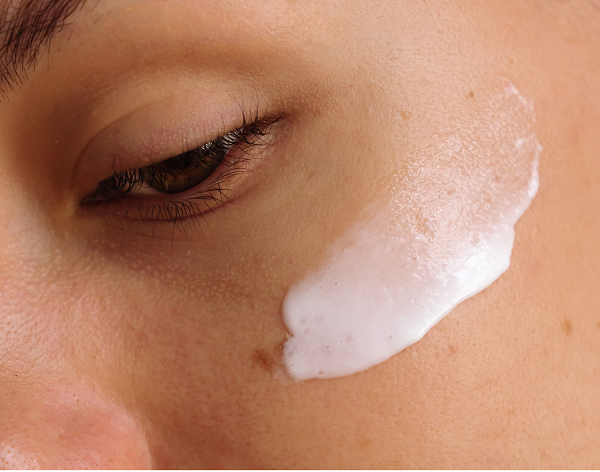The Skin Barrier Explained, with Dr Anjali Mahto

What is the Skin Barrier?
Skin is considered to be the largest organ of the human body accounting for 12 to 15% of body weight and covering 1.5 to 2 square metres of area. It is a highly dynamic and complex organ with many specific roles. It forms part of the vital communication network between the inside and outside world.
The skin has three main layers - the epidermis, dermis, and hypodermis. The epidermis or outer layer functions as a barrier and is integral to maintaining healthy skin. The top layer of the epidermis is known as the stratum corneum and is the key component of what we colloquially refer to as the “skin barrier.”
The skin barrier carries out multiple important roles including maintaining hydration or water content at a steady state, selective transport of molecules, mechanical strength, as well as protection against infection, ultraviolet radiation, and reducing oxidative stress e.g., from pollution. The thickness of the skin barrier varies, being thinnest around the eyelids and thickest on the palms and soles.
How does it work?
The skin barrier or stratum corneum is 12-16 layers thick and has often been described as having a “bricks and mortar” structure. Skin cells known as corneocytes form the “bricks;” the “mortar” is composed of intercellular lipids or fats. The lipids are a balance of ceramides (50%), cholesterols (30%) and free fatty acids (20%).
The interaction between the “bricks and mortar” creates an effective physical and moisture barrier. The very outer layer of the stratum corneum has a slightly acidic pH of 4.5 to 6.5 (sometimes known as the acid mantle) due to sebaceous and sweat gland secretion. The acidic pH has antimicrobial properties.
The cells of the skin barrier form from within the deeper layers of the epidermis and migrate upwards. Dead cells are continuously being sloughed off and replaced from the top layers of the skin barrier in a process known as desquamation. Our skin renews itself approximately every 28 days. For the appearance of healthy skin, desquamation needs to happen in a timely fashion – too fast and it will impact the permeability barrier, too slow and clumps of visible skin cells will form on the skin surface. Desquamation or skin shedding can be viewed as natural exfoliation of the skin.
Signs Your Skin Barrier is Compromised
There are many factors which can disrupt the barrier function of our skin. These include harsh cleansing with prolonged use of soaps and surfactants, improper skincare with high concentrations of multiple “actives” in a routine or unnecessary layering of products, environmental factors such as low temperature and humidity, exposure to irritants, increasing age, as well as genetic factors and other underlying skin conditions e.g., eczema or rosacea. These factors can act together or in isolation to increase water loss through the skin surface, leach out lipids and proteins, and potentially drive an inflammatory response in the skin. Alteration in the permeability barrier can also allow enhanced penetration of skincare products being absorbed through the skin and development of an irritant eczema or contact dermatitis.
Visible signs of a compromised skin barrier manifest as redness, flaking, scaling or even cracked or fissured skin. The skin may also feel dry, tight, uncomfortable, painful, or itchy as a result. Sensations of stinging or burning can also be common. 
Caring for Your Skin Barrier
Optimising your daily skincare routine is of utmost importance to restore a healthy skin barrier if it has become compromised. Using a gentle, non-foaming, ph balanced cleanser twice daily, alongside a well-designed moisturiser can improve both appearance as well as uncomfortable sensations associated with a weakened barrier.
A good moisturiser will maintain skin integrity by retaining water content, preventing water loss, and assisting the skin’s natural barrier repair mechanism. This should translate into improvement in dryness or dullness, and skin which feels smooth, soft, and supple.
When choosing a good moisturiser, it is important to be aware that there are three main classes of ingredients: occlusives, humectants and emollients. A well-designed moisturiser will contain a combination of these. Occlusives work by forming a film or barrier over the skin surface preventing water loss by evaporation (e.g., petrolatum, lanolin, and beeswax). Humectants attract water from the deeper layers of the skin and promote normal desquamation (e.g., glycerin, sorbitol, hyaluronic acid). Emollients fill in the gaps or crevices between skin cells (e.g., shea butter, fatty acids). Some moisturisers will also contain special additives such as ceramides, vitamins, and UV filters.
One of the most common reasons in recent years why the skin barrier may become disrupted is the inclusion of many “active” skincare ingredients for either chemical exfoliation or anti-ageing, as well as over-layering of multiple products in a skincare routine. It is important to choose the skincare ingredients your skin needs wisely – just because there are 50 different products available on the market, does not mean that your skin requires them all. The more variables and products one incorporates into their daily routine, the higher the risk of irritation, sensitivity, and barrier compromise.
So, if for example, you are using an acid-containing toner to exfoliate the upper layers of dead skin cells, ensure that your cleanser and moisturiser are not also loaded with the same actives. Opt for a gentle cleanser and supportive moisturiser to prevent short-term sensitivity and long-term damage to the skin. This is one of the simplest ways of supporting your skin barrier function to allow for healthy skin, which is characterised by smooth texture, elasticity as well mechanical strength.
- Tags: all Skin Science

